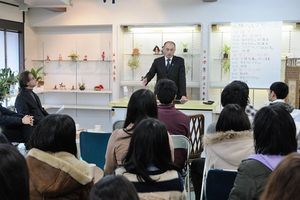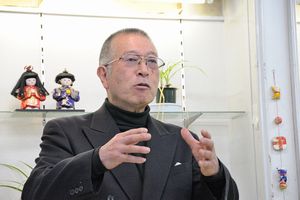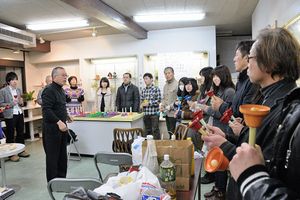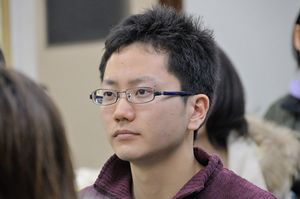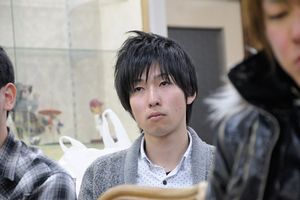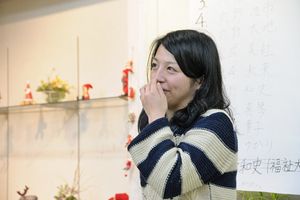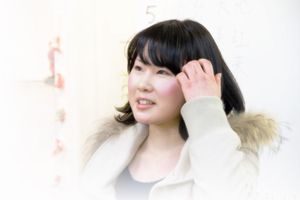Supporter and the Supported
Touhoku HELP founded NGO “Wakabayashi HELP” which provides support to the temporary housing.
Here, many volunteer gather. It is because “Wakabayashi HELP” is a group of “Supporters”.
But, the “Supporters” learn something necessary in life through supporting others. This becomes a valuable experience which supports and aids the “Supporter”.
As a matter of fact, the relationship of “Supporter/Supported” is not fixed. It always wavers, and change places. If not, the dignity of the “supported” would be bitterly and deeply hurt.
The “Supporter” realizes that they are nurtured through “supporting”. In order to confirm these things, director Kurosu planned a project. The following are the report of this project.
This report is written by Kato a graduate student. It is a good report in which we can feel youthfulness and tenseness. Please visit the following report.
(Written by: Naoya Kawakami March 7th 2012 )
*********************************************************
February 12th Wakabayashi HELP Funfest Report
Responsible for wording: Fumiya Kato
Date and Time: February 12th 2012 (Sun.) 14:30 ~ 21:00
Place: Kawara Town Kyusennan Dorakuten
Participants: 22 (including 11 students)
A year is almost going to pass from the great earthquake.
A little while back, we took part in the disaster relief work in many ways, and without noticing it we were in contact with Wakabayashi HELP.
Members who gathered here are precious to each of us. They are buddies difficult to come by. Each has their own visions, and motives to practice them.
The concept of this Funfest was to make this an opportunity to get to know each other more through this social gathering, in order that we may all be able to cooperate more than before in the activities we partake in.
This funfest proceeded in the order of “Lecture”, “Ice Breaking”, “Speech by Student”, and “Free time to chat”. Following are the reports.
☆Lecture (14:30~16:30)
Takayoshi Kikuchi a Sendai City Council, and Eisho Yoshida, chief priest of Eisho-temple in Yamanashi Prefecture had been invited this time, and they gave lecture on the activity of Earthquake Recovery Project, each from their own perspective.
Kikuchi’s lecture was titled “Crisis Management Structure of Japan in the future”.
He emphasized from his experience and from his career till present, that a lateral connection of the government and the civilian will establish a strong Crisis Management Structure.
This time the deductive Crisis Management structure of the government somewhat exerted its strength, but even then there were times when the vertically divided assigned function was not working at the periphery. The things which filled in the gap this time was the inductive civil management stature by the civilian, which is the attitude of mutual assistance of local people rooted in Tohoku area, and the strength of volunteers who gathered from all over Japan.
If this disaster by the earthquake had occurred in a different part of Japan, where the tradition of mutual assistance does not exist, perhaps more harm would have occurred, which we had been lucky to avoid this time.
Therefore, the posture of the government regarding Crisis Management should be, establish contacts with the civilian frequently from now on, thus understanding the strength of civilians which attends to the minutest detail.
The lateral connection, which does not wait for the decree from above, should be able to produce aid according to its kind, and also quickly, which changes every moment.”
Saying thus, Kikuchi also appealed to the college students, “The experience of yours which you’ve acquired by involving yourself in the volunteer activity will be a strong strength next time if any other earthquake occurs. Please write it down so that you may not forget the activities which you partook in.”
A year will pass away soon since the Tohoku Great Earthquake occurred, almost before anyone realizes. I had been feeling relief, thinking that the Great Earthquake has now become the things of past, and something similar shouldn’t occur again. But then I realized that though it is good to help with the restoration, we should not think this as the one-sided aid, but should remember that it is not a surprise if we ourselves become afflicted by the disaster any time. And for this reason, I felt that it was necessary for us to have a firm posture to learn.
The lateral connection cultivated at Wakabayashi HELP this time, will for sure to demonstrate its strength in the future crisis.
Yoshida with his lecture title “Pedagogy of nurturing”, explained to the college students who support teaching from his view point on his volunteer activity until now, and from the history of education, on how to develop the ability of children to live in a society, and its importance.
Japanese word “Learn(ma-na-bu)” derives from the word “imitate(ma-ne-ru)”. Education is originally an act of inheriting wisdom, in order for human to live in a community.
Modern time school education came in effect after the war around 1960’s, and Japan when they imported this new education principle from the United States, adopted the vertically divided deviation value system.
This resulted in making pupils and students to be cautious only in giving one right answer to each question, and decreased the number of people who would speak up their own thoughts. This is one big twist in Japan’s school education.
In the field of education, we need to educate the children with social education to support their strength to live on their own, and not only with the knowledge gained at school. In order to do this, it is necessary to have the children participate in many activities, and provide them with the opportunity to learn the importance of human to help each other, by first starting with the coping of things in a small group.
These things were spoken by Yoshida.
All the students had doubts in their hearts, if the education aid consisting of just teaching regular studies was right. Of course no one thought it was right, but they could not make judgments of what else they should help to educate, besides the regular studies, and how.
Hereupon, the students asked Yoshida of the issue that had been the target of discussion among the students working on education aid. This problem was with the greeting custom of children. They asked if it was necessary to teach this greeting manner, and if it is necessary, then in what way it should be taught.
Yoshida answered, “Greetings is a first step for the community to live pleasantly. It would be great if this could be taught.
Concerning the way to educate them to greet, though it is good to first make a certain form and have them practice this everyday making it a habit, the best way is for you yourselves to greet the children pleasantly. In so doing, the children would be able to understand the importance of greeting, and when the children understand its importance, they will naturally start greeting.”
As was said before, we were reminded again that “learning” comes by “imitating”, and felt that we should reconsider our posture of teaching children.
☆Ice Breaking (16:30 ~ 18:00)
When the lecture of the above lecturer ended, a time was provided for all to make friends with the people who had come to this social gathering.
First, Shunyo Ohashi a Shakuhachi (bamboo flute) teacher, who was participating in this social gathering, presented Shakuhachi performance. Everyone listened intently to the beautiful sound of Shakuhachi which is hard to come by, and there was a big applause when the music ended. Even the lay person was able to tell that the performance was great and the music beautiful.
Next, everyone enjoyed the hand bell performance which Yoshida had brought. “A man can do nothing alone, but when they cooperate, great things could be accomplished.” After Yoshida addressed as above, a hand bell was handed to each one, and everyone cooperatively played one piece of music. Some participants had a mystified look on their faces at first, but as the sound became a music, their faces changed into a smile.
Since anyone could easily ring a bell, I think that this instrument is fit for the enjoyment among all ages.
For a finale we all played a game called “IT guessing names”, and all the participants enjoyed it. The one assigned by the IT, had to speak up the full name of the person designated to him/her. If the one assigned by the IT could not guess the name of the designated person, he/she becomes the IT. It was a good opportunity to willingly learn the name of the participants of this gathering.
☆Speech by Students (18:00 ~ 20:00)
The total of 11 college students from Miyagi University of Education, Tohoku Fukushi University, Shirayuri College, and Tohoku University participated in this social gathering, and each one was due to give some speeches.
The theme of the speech was entirely free for them to choose, but had one condition that they should speak from their own point of view, and questions that arises regularly, within ten minutes. While having supper and pork miso soup which the college students prepared for the gathering, the total of 11 students stepped forward and gave speech one by one.
Most of the students spoke what they felt from the disaster of the earthquake, and the change they felt of themselves, but among them were some that spoke of their interests, or the dream of their future.
Through the speech of those whom we frequently see when working together, we got to see their new side, and of those whom we met for the first time, the speech changed the first impression of that person. The thing that was common with all of the speeches was, it came out of their honest heart, which made the speech worth hearing.
Because opportunities like these are rare to them, all the students were nervous in the beginning, but as the speech time elapsed, everyone became relaxed, and was able to give their speech actively. There were some that became quite passionate while speaking and finished their speech in tears. We were able to spend a meaningful time.
Though some were regular volunteer buddies up till now, we hardly ever had an opportunity to express our own opinion. So the presentation we were able to make, worked to promote a better understanding of each other. Since all of them are precious buddies whom we were able to meet specially through Wakabayashi HELP, we would like to have a relation where we all could learn from each other. For this reason, I felt that the opportunity for this kind of gathering is very necessary.
☆Free time to Chat (20:00 ~ 21:00)
The final hour was spent for the participant to freely chat, since a better understanding of each other had been made.
When the gathering was first commenced, they were many who hung together with their buddies, but when the final hour came, most of the people were aggressively talking with whom they had just met that day.
I believe that the participants were able to develop further relation using this time.
(Period)
